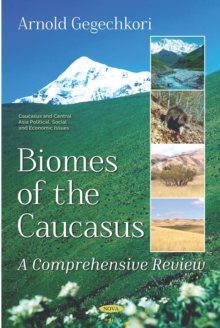The present monograph by Dr. A M. Gegechkori Biomes of the Caucasus: A Comprehensive Review (about 450pp.) is the first scientific-educational work in English on this topic. The Caucasus Isthmus between the Black and Caspian Seas (38025' and 47015N, 36030' and 50020E) is a region in the Northern Hemisphere.
It covers an area of approximately 441,000km2. Being a natural bridge between Europe and Asia, the Caucasus is an extraordinary crossroads in terms of its geopolitical status, cultural heritage, and biodiversity. The Caucasus is famous for having some of the richest biodiversity, making it one of the 34 most diverse and endangered biodiversity hotspots in the world.
The region occurs from among the lush, broad-leaved forests along the Black Sea coastal area, to the well-expressed nival zone and the deserts of the eastern Caucasus.
Flora within the Caucasus is diverse, with about 6,300 species of vascular plants, 1,600 of which are endemic and relict endemics (25.3 %). Biota of the Caucasus has always aroused the interest of scholars.
Studies conducted by botanists and zoologists on the biodiversity of the Caucasus started in the beginning of the 18th century.
Such research activities were relatively short-term, and based solely on either plant or animal investigations.
Long-term, comprehensive (floristic, faunistic, biogeographical) studies of the wilderness of the Caucasus in all biomes and altitudinal zones, and in all vegetation seasons, were carried out by Dr G.
Radde in the late 19th and early 20th centuries, and Dr A.
M. Gegechkori in the second half of the 20th and early 21st centuries.
In the framework of the Caucasus biota, the main target of research activity of Dr. Gegechkori (1962-2018) was psyllids (Insecta; Hemiptera: Psylloidea) a highly indicative (bio-indicator) group for environmental research. This text aims to provide information for naturalists, concerning the biota of the Caucasus, through its biomes, amd refugial areas and habitats.
The work is focused on supplying a datebase for the current presence and distribution of many speceis, with an emphasis on the keastone species, the existance and range of which face major challenges and threats today, caused primarily by humans direct and indirect activity, and global warming. The book incorporates the most recent taxonomic ranking of plants and animals species in the Caucasus, and the regularity and history of its biomes, among other topics.
The monograph is also heavily illustrated with mostly original color photos, which reinforce the scientific quality of the text. This book will be of great interest to scholars of life and earth sciences and geographers.
As an interdisciplinary work, the monograph provides students of all levels with valuable information on the environmental sciences, which may isnpire them to pursue this topic within natural science, stimulating their research and career choices. Finally, the purpose of the work is to strenghten the readers awareness of the environmental challenges among the local people of the Caucasus, in light of on-going environmental changes, and the necessity of protection of this regions natural resources.


